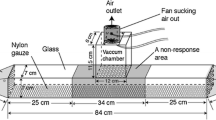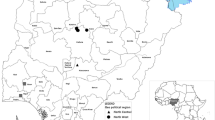Abstract
The Nasonov pheromone of the honeybee comprises seven components, (Z)-citral, nerol, geraniol, nerolic acid, geranic acid, and (E,E)-farnesol. Bioassay of individual components showed each attracted foraging bees. A mixture of components in proportions present in the honeybee was as attractive as the natural secretion, and each component contributed to the attractiveness of the mixture. Honeybees responded anemotactically to the source of Nasonov odor. The presence of footprint pheromone enhanced the attractiveness of the synthetic Nasonov mixture. Nasonov and footprint pheromones may prove useful in attracting honeybees to crops needing pollination.
Similar content being viewed by others
References
Boch, R., andShearer, D.A. 1962. Identification of geraniol as the active component in the Nassanoff pheromone of the honey bee.Nature 194:704–706.
Boch, R., andShearer, D.A. 1964. Identification of nerolic and geranic acids in the Nassanoff pheromone of the honey bee.Nature 202:320–321.
Butler, C.G. 1970. Some chemical and other factors controlling the behaviour of honeybees.Report of the Central Association of Beekeepers, Ilford, England, pp. 1–12.
Butler, C.G., andCalam, D.H. 1969. Pheromones of the honeybee-the secretion of the Nassanoff gland of the worker.J. Insect Physiol. 15:237–244.
Butler, C.G., andFairey, E.M. 1964. Pheromones of the honeybee: biological studies of the mandibular gland secretion of the queen.J. Apic. Res. 3:65–76.
Butler, C.G., Fletcher, D.J.C., andWatler, D. 1969. Nest-entrance marking with pheromones by the honeybee,Apis mellifera L. and by a wasp,Vespula vulgaris L.Anim. Behav. 17:142–147.
Ferguson, A.W., andFree, J.B. 1979. Production of a forage-marking pheromone by the honeybee.J. Apic. Res. 18:128–135.
Free, J.B. 1962. The attractiveness of geraniol to foraging honeybees.J. Apic. Res. 1:52–54.
Free, J.B., andWilliams, I.H. 1970. Exposure of the Nasonov gland by honeybees (Apis mellifera) collecting water.Behaviour 37:286–290.
Free, J.B., andWilliams, I.H. 1972. The role of the Nasonov gland pheromone in crop communication by honeybees (Apis mellifera L.)Behaviour 41:314–318.
Frisch, K. Von 1923. Uber die “Sprache” der Bienen.Zool. Jb. Allg. Zool. Physiol. 40:1–186.
Kalmus, H., andRibbands, C.R. 1952. The origin of the odours by which honeybees distinguish their companions.Proc. R. Soc. Ser. B. 140:50–57.
Lecomte, J. 1957. Scent-marking of sources of food by foraging bees.C.R. Acad. Sci. Paris 245:2385–2387.
Pickett, J.A., Williams, I.H., Martin, A.P., andSmith, M.C. 1980. Nasonov pheromone of the honeybee,Apis mellifera L. (Hymenoptera, Apidae). Part I Chemical characterization.J. Chem. Ecol. 6:425–434.
Pickett, J.A.,Williams, I.H.,Martin, A.P., andSmith, M.C. 1981. The Nasonov pheromone of the honeybee,Apis mellifera L. (Hymenoptera, Apidae). Part III Regulation of pheromone composition and produtionJ. Chem. Ecol. (accepted for publication).
Ribbands, C.R. 1955. The origin of bee scents,British Bee Journal. 88:328.
Shearer, D.A., andBoch, R. 1966. Citral in the Nassanoff pheromone of the honey bee.J. Insect Physiol. 12:1513–1521.
Wall, C., andPerry J.N. 1978. Interactions between pheromone traps for the pea mothCydia nigricana (F.)Entomol Exp. Appl. 24:155–162.
Waller, G.D. 1970. Attracting honeybees to alfalfa with citral, geraniol and anise.J. Apic. Res. 9:9–12.
Weaver, N., Weaver, E.C., andLaw, J.H. 1964. The attractiveness of citral to foraging honeybees.Prog. Rep. Texas Agric. Exp. Sta. No. 2324. 7 pages.
Williams, I.H.,Pickett, J.A., andMartin, A.P. 1982. The Nasonov pheromone of the honeybee,Apis mellifera L. (Hymenoptera, Apidae). Part IV. Electrophysiological bioassay of the components (in preparation).
Author information
Authors and Affiliations
Rights and permissions
About this article
Cite this article
Williams, I.H., Pickett, J.A. & Martin, A.P. The Nasonov pheromone of the honeybeeApis mellifera L. (Hymenoptera, Apidae). Part II. Bioassay of the components using foragers. J Chem Ecol 7, 225–237 (1981). https://doi.org/10.1007/BF00995745
Received:
Revised:
Issue Date:
DOI: https://doi.org/10.1007/BF00995745




